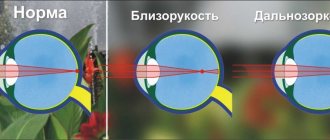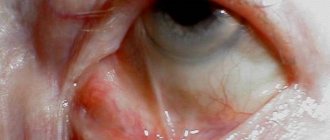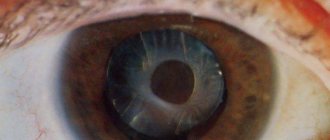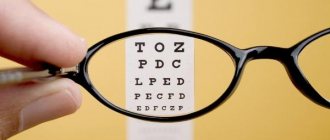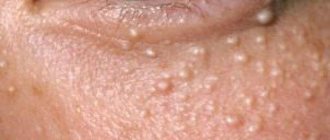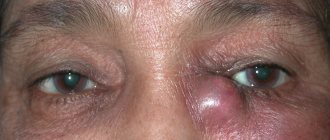The health of the visual organs is the main guarantee of clear perception of the surrounding world. Aging also affects the eyes, often leading to such unpleasant consequences as age-related farsightedness or presbyopia. This condition creates discomfort, and therefore the issue of prevention and correction of this pathology is quite acute today.
Upon reaching a certain age, usually between 45-50 years, serious changes begin to occur in the human body. Of course, they can begin earlier - it all depends directly on immunity, lifestyle and the presence of chronic
In this article
- What is presbyopia?
- The main symptoms of age-related farsightedness
- Causes of age-related farsightedness
- Diagnosis of age-related farsightedness
- What do you need to know about vision correction for presbyopia?
- Spectacle correction of presbyopia
- Vision correction for farsightedness using lenses
- How to correct farsightedness using physiotherapeutic methods?
- Surgical treatment of farsightedness in adults
diseases. It is not surprising that similar changes affect vision. What pathologies can cause deterioration in visual functions at this age, is it possible to eliminate them in a timely manner, and most importantly, to permanently recover from age-related farsightedness?
What is presbyopia?
Presbyopia, which is often called “senile” farsightedness, is an ophthalmological disease; its development directly depends on how old a person is, whether he has had any eye injuries during his life, etc. Presbyopia consists in the fact that objects located at a close distance cease to be bright and contrasting. Can this condition be corrected or not? As ophthalmologists assure, the degree of development of this pathology depends on the state of the visual apparatus of each individual person. The degree of deviation of farsightedness in adults can be different and directly depend on what vision was previously. It is important to understand that presbyopia is a typical manifestation of vision impairment. Age-related farsightedness can easily be compared to the appearance of gray hair or wrinkles on the face. Throughout our lives, the resources of cellular regeneration are exhausted, and therefore we should not expect that the lens or the muscles of the eye will be able to maintain their previous state without needing correction.
Brief description of the disease
Age-related farsightedness or presbyopia is a visual impairment observed in older people. The disease is characterized by the fact that the focus of parallel rays of light after refraction appears behind the retina. The disorder develops due to the fact that a person has a short ocular axis or a thin cornea, which does not allow the rays to be refracted correctly. Presbyopia develops in people after 40-45 years of age; this process is irreversible. This disorder develops with age, as the tone of the eye muscles and the elasticity of the lens decrease.
Important! Unfortunately, farsightedness can also develop in childhood. The disorder occurs due to congenital disorders or genetic predisposition.
The child may complain of eye fatigue, irritability, and poor performance at school. However, at this stage, vision remains normal. It is important to consult an ophthalmologist as early as possible to prevent the development of the pathological process.
Main symptoms of presbyopia
Senile farsightedness is popularly called “long-arm disease,” and this is not surprising. The disease develops gradually, so over time a person cannot clearly see objects up close. However, if you move your hands further away, your vision clarity improves. Unfortunately, this will not always be the case! If you do not start therapy, the disease will progress, and the person will not be able to see anything even with outstretched arms. Presbyopia has the following clinical manifestations:
- eyes quickly become tired and red;
- pain appears;
- pain in the frontal part of the head, as well as in the bridge of the nose;
- near objects the wine is unclear;
- feeling of “sand” in the eyes.
Reasons for the development of senile farsightedness
With age, irreversible consequences develop in the body, which provoke serious diseases. The main reasons for the development of presbyopia include the following factors:
- defective synthesis of collagen proteins and elastin reduces the contractility of the eye muscles;
- the ligaments of Zinn are weakened, which bends the lens and provokes its hardening;
- the lens loses elasticity;
- genetic predisposition;
- mechanical damage to the eyeball.
Often the causes of presbyopia are age-related, and a person cannot influence them in any way. However, it is important to start therapy in a timely manner, as this will help maintain vision at the proper level.
The main symptoms of age-related farsightedness
The first symptoms of age-related farsightedness arise, as a rule, due to the loss of the eye's lens of its former elasticity. In more detail, the organic biconvex lens that is required to provide focal length is renewed throughout life. A healthy lens is composed of unique transparent fibers and is easily able to change curvature using the ciliary muscle. That is why it becomes possible to clearly see objects located both at close range and at a certain distance.
As a rule, upon reaching the age of 45-50 years, a dense core may form inside the lens, which gradually becomes sclerotic, thereby preventing the flexibility of the lens. Another cause of age-related farsightedness can be wear and tear of the ciliary muscle and ciliary girdle, which are the main elements in the functioning of the lens.
Symptoms
Age-related farsightedness begins unnoticed. Its first signs are very weak. A person usually does not pay attention to the first symptoms and associates them with other circumstances.
- It becomes difficult to read the smallest font, it merges and begins to flicker; when reading such a font, the eyes quickly get tired and begin to hurt;
- when quickly moving the eyes from close range to the distance, the gaze does not immediately focus clearly, the image remains blurry for some time, sometimes this leads to dizziness;
- the eyes get tired faster, especially in poor lighting, when the contrast between black block letters and the white background becomes more blurred, the text is “lost”, the eyes seem dry, you always want to blink;
- to look into the distance you always need to squint in order to better see individual details;
- small text close up begins to flicker and blur, thin lines become barely noticeable, sometimes the image looks like a separate shapeless spot;
- the same phenomena become noticeable when doing needlework, when you want to move the product away from your eyes in order to see it more clearly.
These symptoms are especially pronounced in the dark and in poor lighting, when the eyes themselves are already tired after a day of work. The eye adapts especially poorly to night vision - in the dark, objects cannot be seen at all
In bright light, especially sunlight, these signs appear much less. The eye sees everything, as with healthy vision. This happens because the diameter of the iris reflexively becomes smaller, and visual acuity increases. The same phenomenon occurs when a person with senile myopia examines objects through a narrow tube.
With presbyopia, a person experiences the “short arms” syndrome characteristic of this condition, when one always wants to move an object away from the eyes, and the length of the arms is “not enough” for a clearer image.
A person should be alerted when, during prolonged work, severe headaches arise, the need to strain vision, blurred vision - all these are the first signs of approaching presbyopia.
Causes of age-related farsightedness
As ophthalmologists assure, the development of farsightedness with age is very difficult to resist. The fact is that already after reaching the age of 30, the ability of the visual organs to accommodate begins to decrease by almost half. After another 10 years - by 2/3, and after 50 - it is completely lost. Deterioration of vision with age-related farsightedness occurs mainly due to the following circumstances:
- the patient has a history of hypermetropia, especially moderate degrees: from +3 to +5;
- various types of ophthalmological injuries, as well as eye pathologies of an inflammatory nature;
- professional activity that involves regular work at the computer;
- chronic diseases, for example: diabetes, hypertension, neurological pathologies, etc.
Causes and provoking factors
Age-related changes against the background of a number of factors lead to disruption of the functioning of the visual organs. The fundamental reasons why this happens are usually as follows:
- Impaired focusing (pathology of accommodation or refraction).
- Cloudiness of the environment or membrane of the eye (cornea, lens, vitreous body, intraocular fluid).
- Diseases in which the retina is damaged and the optic nerve or impulse pathways to the central nervous system are disrupted.
Typically, such phenomena are observed in the absence of activity of the eye muscles. The lens of the eye changes depending on the distance of the object being viewed, its muscles make it convex or flat. If you constantly look only at a computer monitor or text in a book, your muscles relax and atrophy. This leads to visual impairment. Aging of the retina cannot be ruled out. The process of perceiving objects depends on the presence of light-sensitive pigment. Its gradual destruction and slow recovery after 40 years impairs vision.
Often older people develop circulatory problems. Even a slight change in the vascular fundus, which is often observed in atherosclerosis, diabetes mellitus, hypertension and other chronic diseases, leads to deterioration of vision. In the absence of proper treatment, the retina changes and cannot perform its job normally.
An important factor in vision deterioration at any age is constant eye strain. The retina does not withstand if a person is forced to regularly strain them in insufficient light or too bright light.
If vision deteriorates, this may be a consequence of the following provoking factors:
- poor nutrition,
- constant stress,
- overwork and injury (bruise, foreign body getting into the eye),
- intestinal diseases with impaired absorption of necessary substances,
- long periods of time in front of the TV or monitor.
Against the background of changes in vision that characterize age, eye diseases worsen if the patient has previously been diagnosed with cataracts or glaucoma.
Presbyopia
Physiological aging most often leads to insufficiency of accommodation. Doctors call this disease presbyopia, as well as senile farsightedness. It is caused by several degenerative processes. Noticeable changes in the lens (loss of fluid, compaction of the nucleus and capsule) begin at 40-46 years of age and reach a maximum deviation by 60 years of age. At the same time, atrophic changes are observed in the muscles, which lose the ability to contract and change refraction depending on distance.
Clinical manifestations of presbyopia in patients are as follows:
- inability to see small objects at close range,
- merging lines and letters after a short reading time,
- restoration of vision after rest, when lighting increases or when text is moved farther away,
- the occurrence of pain in the forehead, bridge of the nose and the upper part of the eyeball,
- photophobia and lacrimation.
Sometimes pain in the head and eyes covers the entire forehead and spreads to the temples, dizziness and nausea occur.
Cataract
According to statistics, visual impairment in older people is often associated with cataracts (from 60 to 90%). This is a disease in which clouding of the lens occurs.
At the initial stage, the patient experiences:
- flickering of “flies” before the eyes,
- the appearance of dark spots,
- loss of image clarity (doubling or tripling).
At the next stage, vision decreases significantly while the boundaries of its fields are completely preserved. Then only light perception is observed with the loss of the ability to see.
Diagnosis of age-related farsightedness
In order to promptly begin treatment of farsightedness in adults, an ophthalmologist needs to carry out certain diagnostic procedures. Such an examination, done using modern techniques, will confirm the presence of one or another degree of the disease, as well as select the most appropriate correction method. The following procedures will help determine a pathology such as age-related farsightedness:
- visometry, during which the patient is asked to examine letters of different sizes depicted on a poster;
- ophthalmoscopy - examination of the fundus, retina, optic nerve and vascular network;
- refractometry - measurement of clinical refraction of the visual organs, carried out using a refractometer;
- tonometry, which consists of measuring intraocular pressure;
- biomicroscopy - examination of the internal structure of the eyes using a slit lamp;
- Accommodation study - conducting certain texts, including proximetry, ergography and accomodometry.
Eye exercises
Rest breaks spent on social networks are far from the best option. Simply sitting on a chair and looking at one point will also not add sharpness to your vision.
There are a great variety of exercises and techniques to relax tired eyes. Along with relieving tension, they will help improve vision after 40 years.
It is very important to do such training regularly over a long period of time. Of course, the result will not be immediate, but in the end, you will only be amazed at how great simple eye gymnastics helps.
Basic exercises:
- blink frequently while simultaneously focusing your gaze on objects;
- quickly “shoot” with your eyes, jumping from close to distant objects and vice versa;
- without moving your head, you need to “draw” numbers, letters, and various shapes with your gaze;
- You can purchase a book or album with special pictures and, when the opportunity arises, look at them, following the instructions and recommendations of the authors.
After about a month of daily performance of such training, you can notice the first results. Then it is important not to stop there, because such exercise is not only a method of improving vision, but also an excellent prevention of eye diseases in the future.
What do you need to know about vision correction for presbyopia?
Many people who have heard such a diagnosis as “age-related farsightedness” are concerned with the question: is it possible to correct the current situation? Trying to find the answer and choose the most suitable vision correction for themselves, many begin to study thematic sites and forums. We strongly do not recommend that you try to correct farsightedness using miracle eye drops or any other medications.
First of all, you need to make an appointment with an ophthalmologist who, based on the results of the examination, will be able to choose the most effective treatment for you.
It is very important to understand that if age-related (“senile”) farsightedness progresses, then vision correction should be comprehensive and purely individual. You should not spend extra money on medical drugs and eye trainers without even finding out whether they are suitable for you - this can damage your vision even more.
Hardware drugs
Today, pharmacology offers many multivitamin complexes. They do not have a therapeutic effect, but are very effective together with the tips described above. Moreover, they do not require a prescription and can be taken independently. The main thing is not to overdo it.
But all kinds of eye drops are absolutely not recommended to be used without consulting an ophthalmologist, otherwise you can harm yourself.
In any case, for any signs of vision deterioration over the age of 40, the very first thing to do is visit a specialist. He will suggest methods of conservative or alternative treatment. Perhaps, if time is not lost, everything will work out with preventive measures without drastic intervention.
to “Why does vision decline after 40 years and how to improve it?”
- Julia:
03/08/2019 at 08:16
So I had the same problem. I work at the computer, and I stopped paying attention to the fact that my eyes began to get tired quickly. I underwent an examination and was convinced that my visual acuity had indeed dropped. Now, I have made it a rule to take breaks from work more often. It is also very important to blink often so that the membrane of the eye does not dry out. By the way, I want to confirm that carrot juice really has a positive effect. For now I'm doing without glasses.
Answer
- Svetlana:
03/19/2019 at 17:11
I started thinking about laser vision correction; eye exercises, vitamins and various folk remedies help restore my vision a little, but I can’t count on a miracle. And then, I know from myself that sometimes I’m too lazy to do special exercises every day, and the result suffers greatly from this. In general, after forty years, vision declines quickly.
Answer
- Sergey:
03/24/2019 at 19:12
Unfortunately, with age, the elasticity of the lens is lost and there is no escape from this. Of course, you can buy glasses or contacts, but anyone who has tried wearing them knows how inconvenient it is. You can also have surgery, but no one will give you a 100% guarantee of success. For myself, I chose the path of healthy eating, eye exercises and the use of specialized vitamins. So far the improvements are minor, but I'm trying

